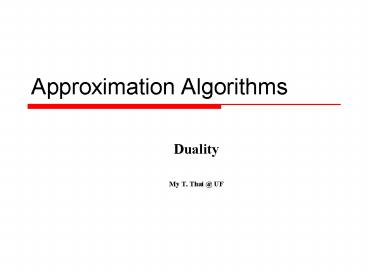Approximation Algorithms - PowerPoint PPT Presentation
1 / 24
Title:
Approximation Algorithms
Description:
Approximation Algorithms Duality My T. Thai _at_ UF * * * * * * * * * * * * * * * * * My T. Thai mythai_at_cise.ufl.edu * Duality Given a primal problem: P: min cTx subject ... – PowerPoint PPT presentation
Number of Views:27
Avg rating:3.0/5.0
Title: Approximation Algorithms
1
Approximation Algorithms
- Duality
- My T. Thai _at_ UF
2
Duality
- Given a primal problem
- P min cTx subject to Ax b, x 0
- The dual is
- D max bTy subject to ATy c, y 0
3
An Example
4
Weak Duality Theorem
- Weak duality Theorem
- Let x and y be the feasible solutions for P and
D respectively, then - Proof Follows immediately from the constraints
5
Weak Duality Theorem
- This theorem is very useful
- Suppose there is a feasible solution y to D. Then
any feasible solution of P has value lower
bounded by bTy. This means that if P has a
feasible solution, then it has an optimal
solution - Reversing argument is also true
- Therefore, if both P and D have feasible
solutions, then both must have an optimal
solution.
6
Hidden Message
Strong Duality Theorem If the primal P has an
optimal solution x then the dual D has an
optimal solution y such that cTx bTy
7
Complementary Slackness
- Theorem
- Let x and y be primal and dual feasible solutions
- respectively. Then x and y are both optimal iff
two - of the following conditions are satisfied
- (ATy c)j xj 0 for all j 1n
- (Ax b)i yi 0 for all i 1m
8
Proof of Complementary Slackness
- Proof
- As in the proof of the weak duality theorem, we
- have cTx (ATy)Tx yTAx yTb (1)
- From the strong duality theorem, we have
(2) (3)
9
Proof (cont)
- Note that
- and
- We have
- x and y optimal ? (2) and (3) hold
- ? both sums (4) and (5) are zero
- ? all terms in both sums are zero (?)
- ? Complementary slackness holds
(4)
(5)
10
Why do we care?
- Its an easy way to check whether a pair of
primal/dual feasible solutions are optimal - Given one optimal solution, complementary
slackness makes it easy to find the optimal
solution of the dual problem - May provide a simpler way to solve the primal
11
Some examples
- Solve this system
12
Min-Max Relations
- What is a role of LP-duality
- Max-flow and Min-Cut
13
Max Flow in a Network
- Definition Given a directed graph G(V,E) with
two distinguished nodes, source s and sink t, a
positive capacity function c E ? R, find the
maximum amount of flow that can be sent from s to
t, subject to - Capacity constraint for each arc (i,j), the flow
sent through (i,j), fij bounded by its capacity
cij - Flow conservation at each node i, other than s
and t, the total flow into i should equal to the
total flow out of i
14
An Example
3
4
3
4
4
3
0
4
2
3
3
4
2
1
t
2
1
s
3
1
1
1
3
2
0
2
3
0
2
1
2
5
0
0
15
Formulate Max Flow as an LP
- Capacity constraints 0 fij cij for all (i,j)
- Conservation constraints
- We have the following
16
LP Formulation (cont)
3
4
3
4
4
3
0
4
2
3
4
3
2
1
3
t
2
1
1
s
1
1
2
3
2
0
3
1
0
2
2
5
0
0
8
17
LP Formulation (cont)
18
Min Cut
- Capacity of any s-t cut is an upper bound on any
feasible flow - If the capacity of an s-t cut is equal to the
value of a maximum flow, then that cut is a
minimum cut
19
Max Flow and Min Cut
20
Solutions of IP
- Consider
- Let (d,p) be the optimal solution to this IP.
Then - ps 1 and pt 0. So define X pi pi 1
and - X pi pi 0. Then we can find the s-t cut
- dij 1. So for i in X and j in X, define dij
1, otherwise dij 0. - Then the object function is equal to the minimum
s-t cut
21
LP-relaxation
- Relax the integrality constraints of the previous
IP, we will obtain the previous dual.
22
Design Techniques
- Many combinatorial optimization problems can be
stated as IP - Using LP-relaxation techniques, we obtain LP
- The feasible solutions of the LP-relaxation is a
factional solution to the original. However, we
are interested in finding a near-optimal integral
solution - Rounding Techniques
- Primal-dual Schema
23
Rounding Techniques
- Solve the LP and convert the obtained fractional
solution to an integral solution - Deterministic
- Probabilistic (randomized rounding)
24
Primal-Dual Schema
- An integral solution of LP-relaxation and a
feasible solution to the dual program are
constructed iteratively - Any feasible solution of the dual also provides
the lower bound of OPT - Comparing the two solutions will establish the
approximation guarantee































